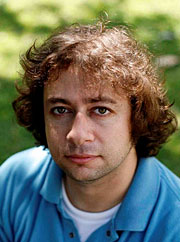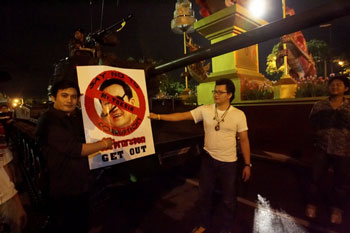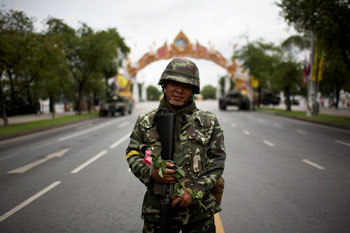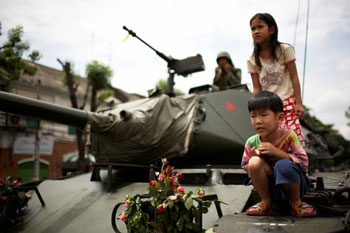 |
Thailand's Rose Revolution
November 2006
|
 |
||||||||||||
|
It had been just another Tuesday night at home in Bangkok. I was just sitting down with a cup of tea and was about to continue with the never-ending task of scanning my archive when my mobile phone rang. It was my friend Steve.
"Rich, there's been a coup!!!" "Err, what!" "There's been a coup; there are APCs rolling down Silom Road right now mate, get your kit!"
The report said that heavily armed troops, along with tanks and armored personnel carriers, had taken up positions around the Government House and the Royal Plaza areas of the city. The coup makers called themselves the "Democratic Reform Council," led by General Sonthi; it said they comprised the commanders of the three armed forces and the national police chief.
Thailand has been caught in a political limbo for months now after massive anti-government protests forced Prime Minister Thaksin Shinawatra to hold early general elections last April. With the opposition parties boycotting those elections and demanding the prime minister's immediate resignation, the results were annulled and Thaksin Shinawatra took on a caretaker role until new elections could be held in October. There had been quiet rumors of a coup for some time as Thaksin's detractors accused him of stall tactics regarding the new elections.
"Rich, you know what's going on right?" "Yeah, I'm on my way out the door right now." "OK great, I have got you two days on this with Newsweek magazine. Get what you can tonight and file something by tomorrow morning my time, OK?"
Ten minutes later I was on the back of a motorbike taxi speeding my way towards Government House, close to the Royal Plaza. During the ride there I noticed how totally normal things on the streets appeared to be. The traffic was moving around smoothly, food stalls were open with customers sitting at tables. I thought to myself, do they know what's going on? Or perhaps they know something I don't? Either way my thoughts were drowned out, quite literally, as the skies above Bangkok opened up. We sought refuge at a bus shelter until the storm passed.
The first signs I see that there has even been a coup appear when I arrive at Government House. Two M-41 tanks, plus around 30 heavily armed troops, have taken up positions on either side of the road. An ever-increasing crowd of media and curious onlookers surrounds each of the tanks. Spotlights from the world's TV news crews illuminate the scene; people taking pictures of themselves on their camera phones far outnumber them, however. I get what pictures I can in the dark and through the drizzling rain and then jump back onto my waiting motorbike taxi and head for the Royal Plaza.
After a couple of hours' sleep I got a call from another friend of mine who was also covering the story. We arrange to meet outside the Thai military headquarters about an hour later. The scene that I arrive to is so unbelievably different from the one I saw the night before. There are now huge crowds of people gathered at the main gate, and they are all holding large bunches of what appear to be roses. As I get closer and move in and amongst the crowds I see that roses have been put all over the place. Soldiers are holding bunches of them; they are in their pockets, in their helmets, even poking out from the barrels of their M-16 rifles. The tanks and armored vehicles lining the roads have roses placed in every conceivable nook and cranny and every time a vehicle enters or leaves the Thai military compound it is showered by a hail of flora, along with cheering and clapping from the crowd. I even witness small children clambering up onto tanks to pass flowers to the crew sitting on the turret. The soldiers and tank crews themselves look relaxed as they pass the time reading newspapers and eating food, much of it handed to them in large plastic bags by members of the public.
I spent the rest of the day hopping in and out, and on and off various types of transportation while trying to get as much coverage of the story as I can. Throughout my day I crisscross Bangkok, going from the Royal Grand Palace to Hualamphomg train station and from the shopping malls in Siam back to the Royal Plaza once again. But as my New York deadline starts to loom I make the decision to call it a day and head home to file the day's take.
As I look through my pictures I cannot help thinking to myself, "Where will this all lead?" The new government has stated that these measures are only temporary and that it will restore power back to the people in the form of general elections as soon as possible. I hope that the festive scenes that I have witnessed over that last 24 hours will lead to a peaceful and transparent transition of power.
As I finish captioning the last picture and get ready to file I realize with complete horror that my Internet connection is down. Is this the final move by the coup leaders to block all international news coverage? With 30 minutes to my deadline, I hop in a taxi and head to the Landmark Hotel on Sukhumvit Road to use the 24-hour Wi-Fi that I know they have in their lobby. I make the deadline, just. It's 4 a.m.
© Richard Humphries
Dispatches are brought to you by Canon. Send Canon a message of thanks. |
|||||||||||||
Back to November 2006 Contents
|
|



